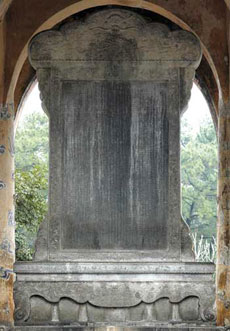Among the most valuable artefacts left by the Nguyen Dynasty is King Tu Duc’s gravestone, with an engraving by the king in which he takes a critical look at himself.

The gravestone, carved with the “Modest and Respectful Biography†written by King Tu Duc (1829-1883), has been selected by historians as the only Vietnamese epitaph in history.
It was part of a stele made of monolithic marble, over 4m high, 2.6m wide and weighing 22 tonnes and made at King Tu Duc’s tomb in the former imperial city of Hue in 1875. It was recorded as the highest and heaviest stele in the country by Guinness Records Vietnam in 2008.
The stele was carved on both faces with the upper side engraved with the standard ancient Chinese scripts called Kaisho and the other side chiselled with the ancient Chinese script known as Haengseo.
Tu Duc’s self-biography is over 4,800 words long and consists of five parts, in which the king wrote about his life, his empire-building as well as his bad luck and illness. In the fifth part, the king acknowledged the numerous mistakes and misdemeanours he was guilty of. He confided that sometimes he had trusted the wrong people and had also been badly behaved on many occasions.
The Director of the Museum on Hue Royal Palace Artefacts, Nguyen Phuoc Hai Trung, said that most of the epitaph had been written by successors to posthumously salute the achievements the former ruler had made as well as his merits. Unlike others, in his epitaph, the King did not hail his successes but wrote down his feeling of shame for failing to provide for the country and his people.
“Self-criticism before history is not easy for people, especially for the one who was at the peak of his power like King Tu Duc. The stele is therefore not only a tangible asset but also an asset to literature and art†Trung emphasised.
The collection of valuable artefacts left by the Nguyen Dynasty, which has been proposed as national assets, includes a throne from the Thai Hoa Palace, a shuttlecock in the shape of nine dragons fighting for a pearl, a collection of four brass bells and a melodic stone.
All are on exhibition at the Museum on Hue Royal Palace Artefacts.